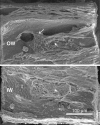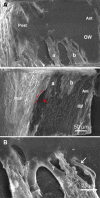Anatomical Variation of Human Collector Channel Orifices
- PMID: 26975026
- PMCID: PMC4794087
- DOI: 10.1167/iovs.15-17753
Anatomical Variation of Human Collector Channel Orifices
Abstract
Purpose: To examine the anatomical variation of normal human collector channel orifices and their relationship with Schlemm's canal.
Methods: Ten human anterior segments fixed by immersion or perfusion were dissected radially and further divided by fine dissection into corresponding inner and outer wall segments. The tissues were dehydrated, critical-point dried, sputter coated, and examined by scanning electron microscopy. Images were obtained at magnifications from ×200 to ×10,000. Selected radial collector channel regions were processed for plastic embedding.
Results: Two classes of collector channel orifices were identified. Simple oval orifices (54.7 ± 4.6-μm diameter) were lined with endothelial cells and most often occurred on a planar region of Schlemm's canal outer wall. Complex orifices (62.7 ± 3.4-μm diameter) were often found associated with septal columns and bridges, and typically covered with flap-like structures (10-40 μm) that extended between the inner and outer wall and over the collector channel orifices. Both simple and complex orifices had complete or partial lip-like rims. In orifices with partial rims, a trough-like groove was often visible on the outer wall surface opposite the lip. Transected septa and inner and outer wall adhesion sites were often found in association with complex collector channel orifices.
Conclusions: Collector channel orifice structure varied from simple ovals to complex tethered flaps and bridges. Collector channel orifices with complex flaps connect the inner and outer walls of Schlemm's canal, and may serve to enhance and regulate aqueous outflow in these regions.
Figures






References
-
- Chader GJ. Key needs and opportunities for treating glaucoma. Invest Ophthalmol Vis Sci. 2012; 53: 2456–2460. - PubMed
-
- Maepea O,, Bill A. The pressures in the episcleral veins, Schlemm's canal and the trabecular meshwork in monkeys: effects of changes in intraocular pressure. Exp Eye Res. 1989; 49: 645–663. - PubMed
-
- Maepea O,, Bill A. Pressures in the juxtacanalicular tissue and Schlemm's canal in monkeys. Exp Eye Res. 1992; 54: 879–883. - PubMed
Publication types
MeSH terms
Grants and funding
LinkOut - more resources
Full Text Sources
Other Literature Sources

